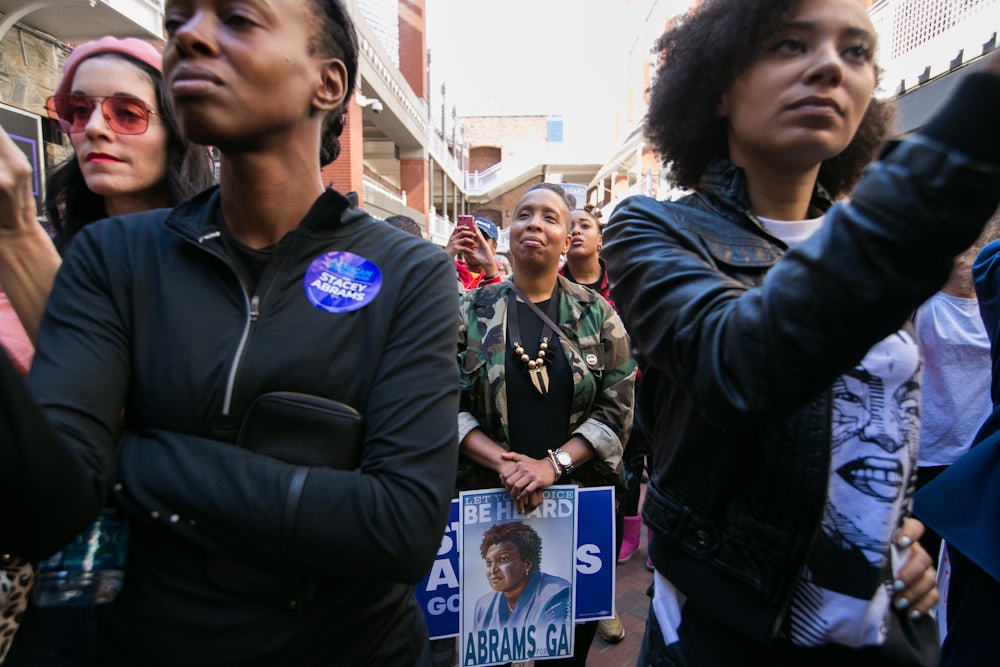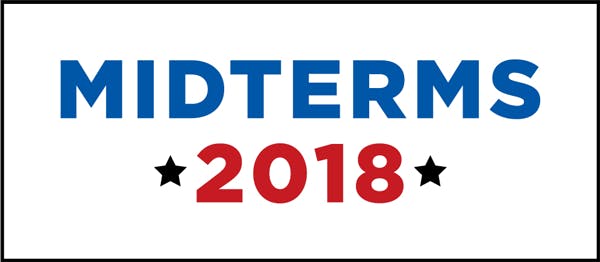Chief Justice John Roberts made a bold declaration on the state of American race relations in 2013. “Our country has changed,” he concluded in his majority opinion in Shelby County v. Holder, “and while any racial discrimination in voting is too much, Congress must ensure that the legislation it passes to remedy that problem speaks to current conditions.” With those words, he and the court’s conservative majority gutted a key provision of the Voting Rights Act of 1965.
Brian Kemp, Georgia’s secretary of state, seems to be on a one-man mission to prove Roberts wrong. The state purged more than 500,000 voters from the rolls under his watch in 2017, raising the likelihood that thousands of voters may be unable to cast a ballot when they show up to the polls next week. The Associated Press reported earlier this month that his office also froze 53,000 voter applications under its “exact match” policy, which allows officials to reject voter registration forms if the applicants’ information doesn’t precisely correspond with state and federal records—even if it’s only off by a comma or a hyphen. Seventy percent of those forms were filled out by African Americans. Kemp is in a tight race for governor against Stacey Abrams, who would be the first black woman ever to hold that position in the country.
Though Kemp is receiving the most attention during this election cycle, his actions are far from unusual. Officials in Republican-led states have enacted a variety of restrictive voting measures over the past decade similar to the ones he’s pursued. They defend these measures as a prophylactic against voter fraud, which is virtually nonexistent. But in practical terms, the greatest effect is to make it harder for thousands of Americans, particularly from disadvantaged communities, to vote. No small share of credit goes to the Roberts Court.
The Voting Rights Act is no ordinary piece of legislation. People died for it. Civil rights activists in the 1950s and 1960s were beaten, bloodied, and even murdered in the campaign to guarantee black Americans ballot access. Once enacted, it proved to be a powerful tool at sweeping away the last vestiges of Jim Crow and ensuring that states where it once thrived would not relapse into past deprivations. Measured by its impact, it ranks among the most effective pieces of human rights legislation passed in the twentieth century.
The law featured two key provisions. Section 2 established a permanent and nationwide ban on racial discrimination in election laws. The VRA’s most powerful weapon, however, was Section 5. That provision established a process known as “preclearance,” whereby certain states and counties with a history of racially discriminatory voting practices had to seek approval from the Justice Department or a federal court in D.C. before making any changes to their election laws. The bulk of the covered jurisdictions were initially in the Deep South. Over time, it expanded to cover Alaska and Arizona to protect Native American voting rights, as well as a smattering of counties throughout the Northeast and the West.
Preclearance amounted to an extraordinary federal intervention in state and local election laws, but the VRA’s drafters argued it was necessary to reverse almost a century of racist voter suppression in the South and elsewhere. “I think it is time that strong medicine be taken for this malady that has come upon us,” Kentucky Representative Frank Chelf remarked during a congressional hearing on the law. “Maybe we need some 110-proof Kentucky bourbon instead of the mild, gentle, soft, mellow, whispering, 86-proof, discriminating whiskey, if you know what I mean. Maybe we even need some block and tackle whiskey. That’s the kind, you know, you take a drink, you walk a block, and you tackle anybody.” The Supreme Court agreed and upheld the procedure’s constitutionality in 1966.
For decades, the law seemed legally and politically secure. Congress reauthorized the VRA with overwhelming bipartisan support in 2006, extending preclearance over certain jurisdictions for another 25 years. But a legal challenge to the extension by a utility board in Texas opened the first crack in the law’s foundation. In 2009, the Supreme Court unanimously ruled in Northwest Austin Municipal Utility District No. 1 v. Holder that the board could apply through the VRA to opt out of preclearance. Roberts, writing for the court, also raised questions about the constitutionality of preclearance itself.
“More than 40 years ago, this court concluded that ‘exceptional conditions’ prevailing in certain parts of the country justified extraordinary legislation otherwise unfamiliar to our federal system,” he wrote. “In part due to the success of that legislation, we are now a very different nation. Whether conditions continue to justify such legislation is a difficult constitutional question we do not answer today.”
Meanwhile, in Georgia, which had been subject to preclearance from the beginning, the VRA was proving as valuable as ever. Before Kemp became secretary of state in 2010, Georgia was twice blocked by the Justice Department from implementing a version of the exact-match policy. But the Obama administration may have seen the warning signs in the Roberts Court’s ruling in Northwest Austin: The Justice Department abandoned its legal fight against the exact-match policy, approving a modified version of the program shortly after Kemp entered office.
At the time, civil rights lawyers suspected that the Obama administration settled the state’s lawsuit to avoid giving the Supreme Court a chance to strike down part of the Voting Rights Act. Those fears were well-founded. When the court took up the issue again in Shelby County in 2013, the conservative justices’ skepticism was apparent.
“Is it the government’s submission that the citizens in the South are more racist than citizens in the North?” Roberts asked during oral arguments. Justice Antonin Scalia made the bewildering suggestion that Congress only reauthorized the VRA in 2006 because lawmakers would not be re-elected if they voted against it, as if that were not how representative democracy should work. “Whenever a society adopts racial entitlements, it is very difficult to get out of them through the normal political processes,” he added.
Civil rights groups warned the Roberts Court that its ruling could have dire implications. “This Court’s decisions in the 1870s to invalidate federal voting rights legislation paved the way for Southern states to enact laws that effectively barred African Americans from exercising their right to vote for many generations,” the Leadership Conference on Civil and Human Rights told the justices in a friend-of-the-court brief. “If this Court were to invalidate Section 5, there is a very real and substantial risk that this history would repeat itself. The Court should not allow this to happen.”
Georgia Representative John Lewis, a civil rights hero, told the court that Barack Obama’s election showed how far the nation had come since Alabama state troopers fractured his skull during the Selma-to-Montgomery marches for voting rights in 1963. At the same time, he warned that the Obama era had also reinvigorated a darker part of the American soul. “In response to more minority voters participating in the political process, six of the nine states fully covered under Section 5 have passed legislation in the last two years designed to restrict voting rights and access to the polls,” he wrote. “These laws hearken back to the days of Jim Crow, and remind us all that we have not left the past behind.”
In the end, Roberts and the other four conservative justices left Section 5 intact, and instead struck down Section 4(b) as unconstitutional. That provision listed which jurisdictions would fall under Section 5. As Justice Ruth Bader Ginsburg noted in her dissent, the House and Senate held 21 hearings on the matter during the 2006 reauthorization and had amassed a 15,000-page record as part of its deliberations. But Roberts and his colleagues swapped out the legislative fact-finding process with their own policy assessment and found the law wanting.
“Congress did not use the record it compiled to shape a coverage formula grounded in current conditions,” Roberts wrote. “It instead reenacted a formula based on 40-year-old facts having no logical relation to the present day.” The judicial sleight of hand meant that the court could avoid striking down preclearance itself. Roberts noted that Congress was free to pass a new coverage formula, but he must have known that the Republican Party had no interest in doing so. Preclearance is now a sword that can’t be unsheathed.
Ginsburg compared the majority’s ruling to throwing away an umbrella because it wasn’t raining outside. But Kemp downplayed the implications of the court’s ruling. “It doesn’t mean that we don’t still have to follow the law or that we won’t get sued if we don’t follow the law,” he told the Atlanta Journal-Constitution. “It just shifts the burden from us having to prove to other groups having to prove [discrimination], and that’s huge for the taxpayers of Georgia.”
While it’s impossible to know how the Justice Department would handle individual preclearance cases today if the provision were still in force, the trajectory in Georgia is clearer, according to Danielle Lang, a staff attorney at the Campaign Legal Center, which has challenged multiple iterations of the exact-match policy in court. “I think it’s a very fair statement overall to say,” she told me, “that we would not see the level of disenfranchisement that we see today if preclearance were still in effect.”

